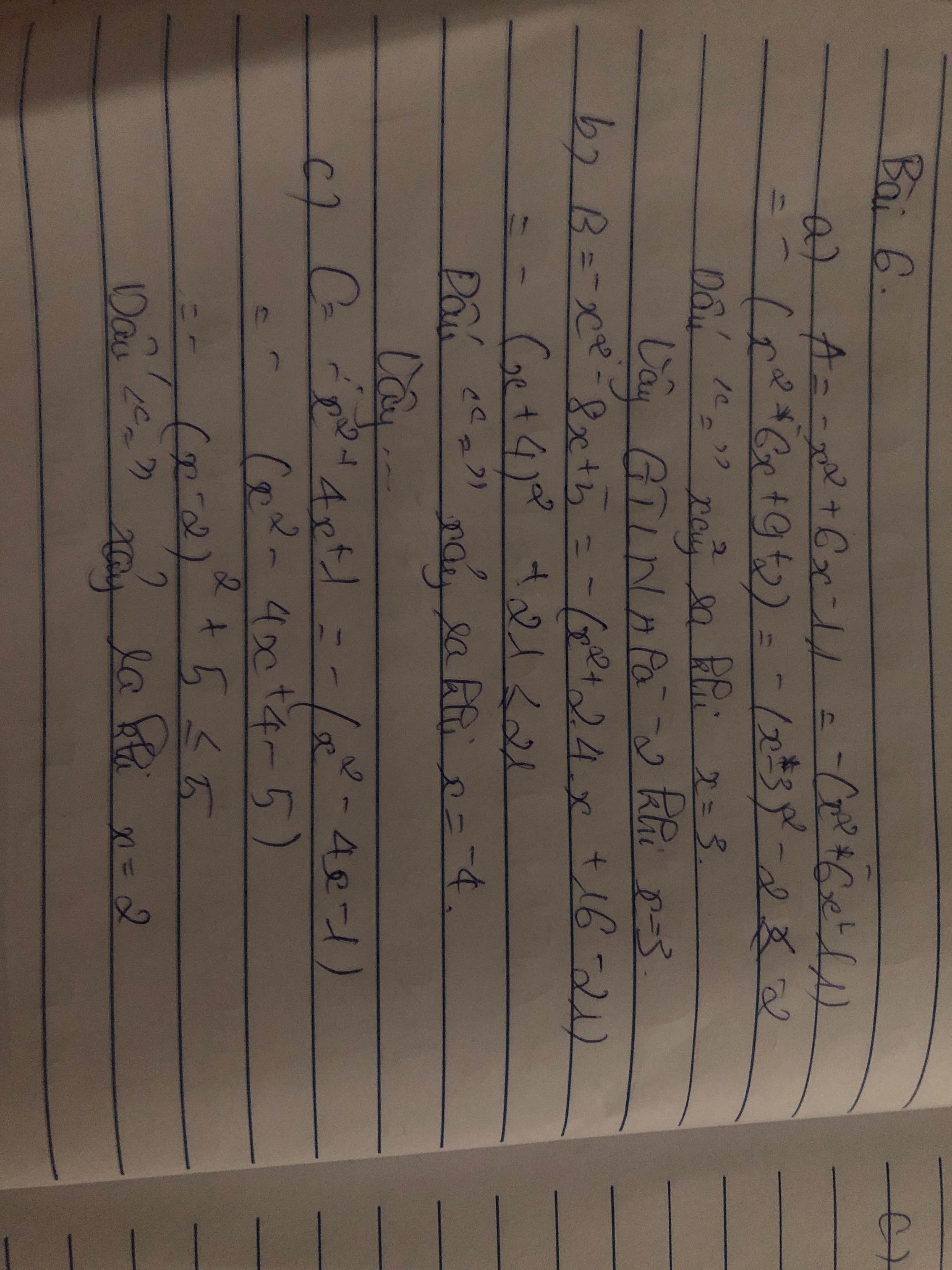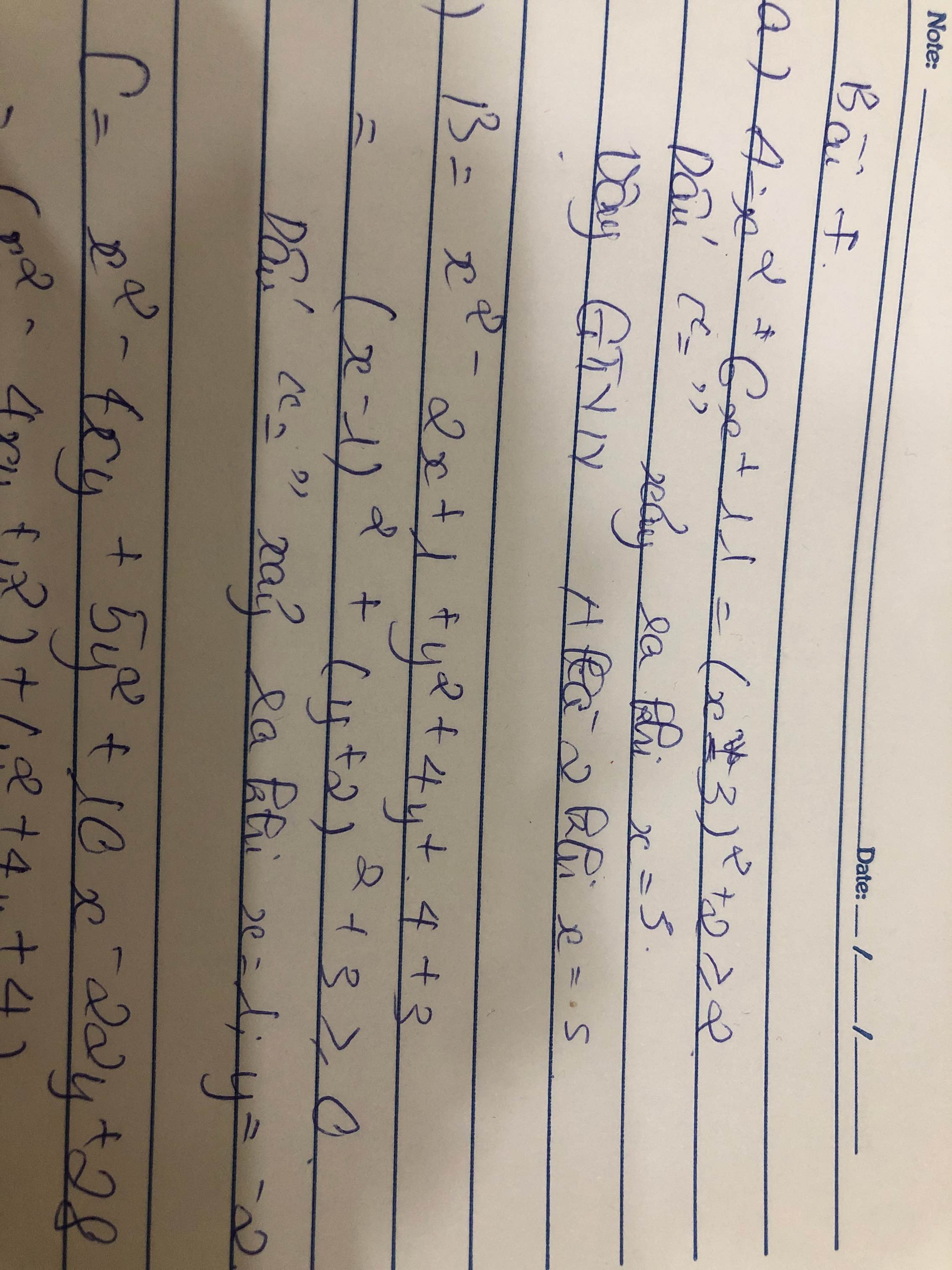Hãy nhập câu hỏi của bạn vào đây, nếu là tài khoản VIP, bạn sẽ được ưu tiên trả lời.

\(A=x^2-4x+20=x^2-4x+4+16=\left(x-2\right)^2+16\)
Do \(\left(x-2\right)^2\ge0\)
\(\Rightarrow\left(x-2\right)^2+16\ge16\)
\(\Rightarrow Min\left(A\right)=16\)
\(B=x^2-3x+7=x^2-3x+\dfrac{9}{4}-\dfrac{9}{4}+7=\left(x-\dfrac{3}{2}\right)^2+\dfrac{19}{4}\)
Do \(\left(x-\dfrac{3}{2}\right)^2\ge0\)
\(\Rightarrow\left(x-\dfrac{3}{2}\right)^2+\dfrac{19}{4}\ge\dfrac{19}{4}\)
\(\Rightarrow Min\left(B\right)=\dfrac{19}{4}\)
\(C=-x^2-10x+70=-\left(x^2+10x+25\right)+25+70=-\left(x-5\right)^2+95\)
Do \(-\left(x-5\right)^2\le0\)
\(\Rightarrow-\left(x-5\right)^2+95\le95\)
\(\Rightarrow Max\left(C\right)=95\)
\(D=-4x^2+12x+1=-\left(4x^2-12x+9\right)+9+1=-\left(2x-3\right)^2+10\)
Do \(-\left(2x-3\right)^2\le0\)
\(\Rightarrow-\left(2x-3\right)^2+10\le10\)
\(\Rightarrow Max\left(D\right)=10\)

a) Ta có: \(25x^2-20x+7\)
\(=\left(5x\right)^2-2\cdot5x\cdot2+4+3\)
\(=\left(5x-2\right)^2+3\ge3\forall x\)
Dấu '=' xảy ra khi \(x=\dfrac{2}{5}\)
b) Ta có: \(9x^2-6x+2\)
\(=9x^2-6x+1+1\)
\(=\left(3x-1\right)^2+1\ge1\forall x\)
Dấu '=' xảy ra khi \(x=\dfrac{1}{3}\)
c) Ta có: \(-x^2+2x-2\)
\(=-\left(x^2-2x+2\right)\)
\(=-\left(x^2-2x+1+1\right)\)
\(=-\left(x-1\right)^2-1\le-1\forall x\)
Dấu '=' xảy ra khi x-1=0
hay x=1
d) Ta có: \(x^2+12x+39\)
\(=x^2+12x+36+3\)
\(=\left(x+6\right)^2+3\ge3\forall x\)
Dấu '=' xảy ra khi x=-6
e) Ta có: \(-x^2-12x\)
\(=-\left(x^2+12x+36-36\right)\)
\(=-\left(x+6\right)^2+36\le36\forall x\)
Dấu '=' xảy ra khi x=-6
f) Ta có: \(4x-x^2+1\)
\(=-\left(x^2-4x-1\right)\)
\(=-\left(x^2-4x+4-5\right)\)
\(=-\left(x-2\right)^2+5\le5\forall x\)
Dấu '=' xảy ra khi x=2

a) Ta có: \(25x^2-20x+7\)
\(=\left(5x\right)^2-2\cdot5x\cdot2+4+3\)
\(=\left(5x-2\right)^2+3\ge3\forall x\)
Dấu '=' xảy ra khi \(x=\dfrac{2}{5}\)
b) Ta có: \(9x^2-6x+2\)
\(=9x^2-6x+1+1\)
\(=\left(3x-1\right)^2+1\ge1\forall x\)
Dấu '=' xảy ra khi \(x=\dfrac{1}{3}\)
c) Ta có: \(-x^2+2x-2\)
\(=-\left(x^2-2x+2\right)\)
\(=-\left(x^2-2x+1+1\right)\)
\(=-\left(x-1\right)^2-1\le-1\forall x\)
Dấu '=' xảy ra khi x=1
( Mình trình bày mẫu câu a các câu khác mình làm tắt lại nhưng tương tự trình bày câu a nha )
a, Ta có : \(25x^2-20x+7=\left(5x\right)^2-2.5x.2+2^2+3\)
\(=\left(5x-2\right)^2+3\)
Thấy : \(\left(5x-2\right)^2\ge0\forall x\in R\)
\(\Rightarrow\left(5x-2\right)^2+3\ge3\forall x\in R\)
Vậy \(Min=3\Leftrightarrow5x-2=0\Leftrightarrow x=\dfrac{2}{5}\)
b, \(=9x^2-2.3x+1+1=\left(3x-1\right)^2+1\ge1\)
Vậy Min = 1 <=> x = 1/3
c, \(=-x^2+2x-1-1=-\left(x^2-2x+1\right)-1=-\left(x-1\right)^2-1\le-1\)
Vậy Max = -1 <=> x = 1
d, \(=x^2+2.x.6+36+3=\left(x+6\right)^2+3\ge3\)
Vậy Min = 3 <=> x = - 6
e, \(=-x^2-2.x.6-36+36=-\left(x+6\right)^2+36\le36\)
Vậy Max = 36 <=> x = -6 .
f, \(=-x^2+4x-4+5=-\left(x^2-4x+4\right)+5=-\left(x-2\right)^2+5\le5\)
Vậy Max = 5 <=> x = 2

Bài 1 :
a) \(a\ne x\)
b) Tại a= 2 PT
\(\Leftrightarrow\left(5.2-8\right)x=2014\)
\(\Leftrightarrow2x=2014\)
\(\Leftrightarrow x=1007\)
Vậy tập nghiệm của phương trình đã cho khi a=2 là \(S=\left(1007\right)\)
Bài 2
Ta có :\(f\left(x\right)=2x^2-12x+14\)
\(=2\left(x^2-6x+9\right)-4\)
\(=2\left(x-3\right)^2-4\ge-4\)
Dấu \("="\Leftrightarrow x-3=0\Leftrightarrow x=3\)
Vậy GTNN của \(f\left(x\right)\)là \(-4\)khi \(x=3\)
Nhớ K cho tớ nhé

Bài 3:
a) Ta có: \(A=25x^2-20x+7\)
\(=\left(5x\right)^2-2\cdot5x\cdot2+4+3\)
\(=\left(5x-2\right)^2+3>0\forall x\)(đpcm)
d) Ta có: \(D=x^2-2x+2\)
\(=x^2-2x+1+1\)
\(=\left(x-1\right)^2+1>0\forall x\)(đpcm)
Bài 1:
a) Ta có: \(A=x^2-2x+5\)
\(=x^2-2x+1+4\)
\(=\left(x-1\right)^2+4\ge4\forall x\)
Dấu '=' xảy ra khi x=1
b) Ta có: \(B=x^2-x+1\)
\(=x^2-2\cdot x\cdot\dfrac{1}{2}+\dfrac{1}{4}+\dfrac{3}{4}\)
\(=\left(x-\dfrac{1}{2}\right)^2+\dfrac{3}{4}\ge\dfrac{3}{4}\forall x\)
Dấu '=' xảy ra khi \(x=\dfrac{1}{2}\)

A = 2\(x\) - \(x^2\) - 4
A = -(\(x^2\) - 2\(x\) + 1) - 3
A = - (\(x-1\))2 - 3
Vì (\(x-1\))2 ≥ 0 ⇒ -(\(x\) - 1)2 ≤ 0 ⇒ -( \(x\) - 1)2 - 3 ≤ - 3
Amax = -3 ⇔ \(x\) - 1 = 0 ⇔ \(x\) = 1
Vậy giá trị lớn nhất của biểu thức là 0 xảy ra khi \(x\) = 1
B = - \(x^2\) - 4\(x\)
B = -( \(x^2\) + 4\(x\) + 4) + 4
B = -(\(x\) + 2)2 + 4
Vì (\(x\) + 2)2 ≥ 0 ⇒ - (\(x\) + 2)2 ≤ 0 ⇒ -(\(x+2\))2 + 4 ≤ 0
Bmax = 4 ⇔ \(x+2=0\Rightarrow x=-2\)
Kết luận giá trị lớn nhất của biểu thức là 4 xảy ra khi \(x\) = - 2



1. \(A=x^2+12x+27=\left(x^2+12x+36\right)-9=\left(x+6\right)^2-9\ge-9\)
Vậy Min A = -9 <=> x = -6
2. \(B=2x-x^2-2=-\left(x^2-2x+1\right)-2+1=-\left(x-1\right)^2-1\le-1\)
Vậy Max B = -1 <=> x = 1